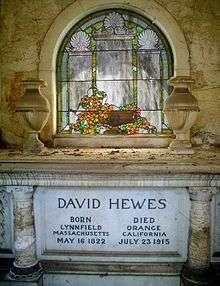David Hewes
David Hewes (May 16, 1822 in Lynnfield, Massachusetts – July 23, 1915 in Orange, California), was an American born into one of the "old families" of Massachusetts that could be traced back seven generations to the patriot Joshua Hewes.[1] Hewes is associated with the construction and completion of the First Transcontinental Railroad, although he was an enthusiastic supporter rather than being directly connected with the construction thereof. He provided the golden spike marking completion of the rail and he also planned the connection of the railroad company's wires to Western Union so the taps of the silver hammer driving the golden spike in Promontory Point, Utah could be heard in San Francisco.

Hewes supported himself from the age of fourteen and earned enough to pay for his education including entry into Phillips Academy, Andover and Yale College. During his second year at Yale he joined his savings with a small inheritance from his father investing the monies in galvanized iron houses that were shipped to California. He travelled by ship and arrived at San Francisco in February 1850 and later set up a general merchandise store in Sacramento. In 1852 Sacramento was devastated by fire and in early 1853 a flood leaving Hewes with little resources. Seeing San Francisco as a promising metropolis of the Pacific Coast he began a small-scale business of earth-moving as the city was leveling sand dunes and filling streets.
Hewes' Steam Paddy Company purchased steam shovels and then built the first steam locomotive on the Pacific Coast.[2] He grew the enterprise to reclaiming the harbor, blocked by hundreds of abandoned ships from the gold rush, to level and fill the area where much of San Francisco's business district now stands. He was called the "maker of San Francisco" because it was through "his initiative and energy that the task was undertaken and accomplished". Hewes was invited to be a part of the Big Four (Central Pacific Railroad) but declined due to the financial risks, over his lifetime he gained and lost several fortunes.[2] Hewes first marriage was to Matilda C. Gray in 1875 and they spent two and a half years in Europe. On the return trip Matilda's health necessitated that they move to a warmer climate. In 1881, they settled in Southern California, building a Victorian-styled mansion that still stands as a historical site in Tustin, CA. Matilda died in 1887. Hewes' second wife was Anna Lathrop, sister of Mrs. Leland Stanford.[3] Married in 1889, they also travelled overseas and additionally to Europe they spent parts of their eighteen months in the Orient and Mid-East. Anna died soon after in August 1892.

Hewes first started what arguably was his greatest accomplishment - the Hewes ranch near El Modena in Orange County when he moved there with Matilda. Called Anapama, "a place of rest", it was a massive sheep ranch over 800 acres (3.2 km2) with a large portion eventually converted in vineyards which later died off from blight. Hewes restored the ranch as a citrus farm which was one of the noted orange groves that stayed with the estate until 1920 when it was sold for $1,000,000. Hewes' art collection of pictures, statues and frescos was presented to the Leland Stanford Jr. University. He also created Hewes Park on what was once a barren hilltop. Hewes died in Orange, California in 1915 at the age of 93 and is buried at Mountain View Cemetery in Oakland.
References
- ↑ "Where to find celebrities resting places", Charlie Wells, SF Chronicle, July 26, 2010.
- 1 2 Camron-Stanford House Preservation Association: David Hewes and family
- ↑ Memorial addresses on the life and character of Mrs. David Hewes, with the funeral services held at the residence of her sister, Mrs. Leland Stanford, San Francisco, Cal., August 6, 1892. (Memorial booklet with biography, 42 pages)
Further reading
- Samuel Armor, History of Orange County, California: with biographical sketches of the leading men and women of the county who have been identified with its earliest growth and development from the early days to the present, Part 1, pages 222-225, Historic Record Co., 1921 (original at the New York Public Library)
- Benjamin F. Arrington, Volume 1 of Municipal History of Essex County in Massachusetts: A Classified Work, Devoted to the County's Remarkable Growth in All Lines of Human Endeavor, More Especially to Within a Period of Fifty Years, page 218, Lewis historical publishing company, 1922 (original from the University of Virginia)